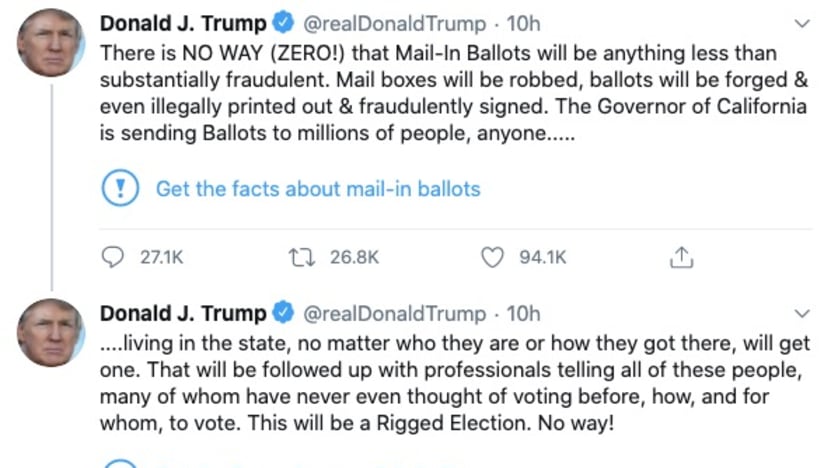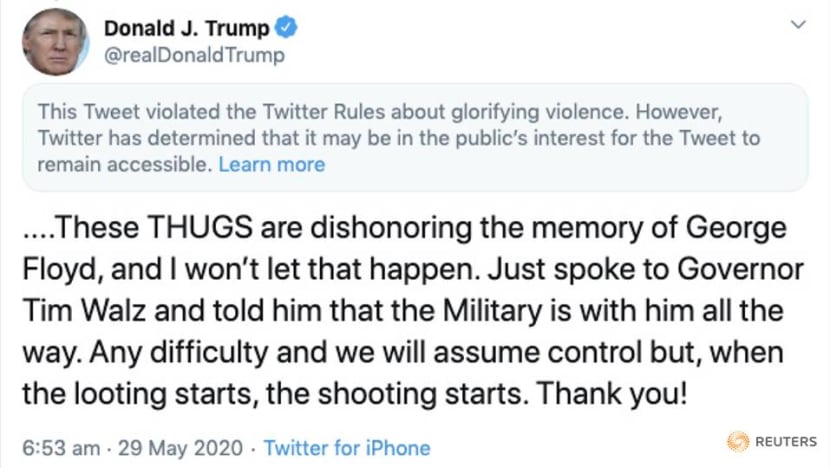commentary Commentary
Commentary: Twitter may have just helped Trump get re-elected
US President Donald Trump may not win his latest battle to change Twitter. But he may succeed in a broader strategy to cast himself as a victim of biased Big Tech, says NTU’s Mark Cenite.

A clash between President Donald Trump and Twitter has escalated in recent days, but more fireworks may be coming if the platform uses additional moderation tools. (Photo: AFP/Olivier Douliery)
SINGAPORE: A legal and political drama is playing out in America.
Twitter has begun labelling President Donald Trump’s tweets: “Unsubstantiated”. “Glorifies violence”.
Trump retaliated with an executive order threatening something that social media firms cherish: Broad legal immunity for the content that we users post.
TWITTER LABELS TRUMP’S TWEETS
Some have welcomed the move. For years, Twitter did little to control discussion on its platform. After misinformation circulated on social media about the 2016 US presidential election and the Brexit vote, and governments responded with inquiries, Twitter stepped up moderation.
But it did not apply the same rules to politicians’ posts because they were deemed “newsworthy”. After all, a politician’s offensive tweet says something about its author that may concern voters.
Then, last month, Trump insinuated in tweets that an MSNBC media host, Joe Scarborough, was involved in the death of an aide in 2001, when Scarborough was a congressman.
The aide’s widower begged Twitter to remove the tweets. Twitter did not, but the incident may have prompted it to finally place disclaimers on politicians’ tweets after promising to do so in 2019.
READ: Commentary: COVID-19 online shaming and the harm it can cause
READ: Commentary: On social media, life amid coronavirus risks becoming a popularity contest
Last week, Twitter labelled tweets in which Trump said mail-in voting, which many states are considering for the November election, will lead to voter fraud and a “rigged election”.
Beneath the tweets, Twitter posted a link — labelled “Get the facts about mail-in ballots” — to a fact-checking page calling Trump’s claims “unsubstantiated”. That linked to media reports on studies showing only an infinitesimally small number of fraudulent mail-in ballots in past elections.

On Friday (May 29), Trump tweeted about protests in Minneapolis against the police killing of a black man, George Floyd: “when the looting starts, the shooting starts”.
Twitter put Trump’s tweet behind a warning that it violates their policies against glorifying violence.
TRUMP’S EMPTY THREAT
That was only a day after Trump issued an executive order calling for a government review of how Section 230 of the Communications Decency Act, a 1996 law that predates social media, is interpreted and applied.
That provision currently gives broad immunity to companies like Twitter against liability even for users’ hate speech, harassment or defamation.
If I defame someone in a letter I write to an American newspaper, I may be liable. So too may the newspaper, for publishing the letter; it is responsible for the content. But the bookstore that sells the newspaper is regarded as a distributor that is generally not liable.
If I tweet the defamatory words, I may be liable, but Section 230 establishes that Twitter will not be. It will be treated like the bookstore rather than the newspaper. Even if Twitter knows that my tweet is defamatory, it can’t be liable, according to courts’ interpretation of Section 230.
By shielding tech companies from potentially crippling liability, Section 230 has helped Silicon Valley companies that host content — Facebook, Twitter, even YouTube — to become household names globally.
READ: Commentary: Big Tech's coronavirus boom could be its undoing
READ: Commentary: Big Tech is showing some love to the US government – which comes as no surprise
It is not an understatement to say this law may be responsible for the Internet as we know it.
Without immunity from liability in America, platforms might screen out all controversial user posts, even Trump’s. Screening would slow online interaction around the world.
The Electronic Frontier Foundation, the US-based civil liberties organisation, calls Section 230 “the most important law protecting Internet speech”.
But Trump doesn't have the power to control the interpretation of a law that Congress passed, much less to enforce his tweets to “revoke 230”.
Further, his executive order could face legal challenges for violating America’s First Amendment, which protects Twitter’s moderation as the firm’s expression.

The most generous interpretation of Trump’s executive order is that it is a fumble that reflects a misreading of Section 230.
His executive order notes that Section 230 said that interactive computer services are “a forum for a true diversity of political discourse”. It appears to be based on the theory that if services moderate content, they must do so neutrally to earn immunity.
But there’s nothing in the letter of the law of Section 230 that requires such neutrality.
READ: Commentary: Forwarding a WhatsApp message on COVID-19 news? How to make sure you don’t spread misinformation
READ: Commentary: Telegram, the powerful COVID-19 choice of communications by many governments
The provision’s co-author, Ron Wyden, a Democratic senator from Oregon, said: “As the co-author of Section 230, let me make this clear: There is nothing in the law about political neutrality.”
So on first sight, Trump’s executive order appears to be an empty threat.
CHARACTER STUDY: WHY TRUMP MADE AN EMPTY THREAT
But keep in mind this latest salvo against social media is part of a story Trump has been telling voters for years.
Even if he loses the legal battle, Trump may succeed in his longstanding effort to cast himself and fellow conservatives as victims who valiantly fight back against “Big Tech” firms and the “fake news media” who treat them unfairly.

America is emerging from lockdowns after more than 100,000 COVID-19 deaths, and many blame Trump for not taking swifter action that might have saved lives.
With the presidential election five months away, polling site FiveThirtyEight, which aggregates the results of several polls, estimates that 53 per cent of Americans disapprove of Trump’s performance.
Another polling data aggregator RealClearPolitics shows presumptive Democratic nominee Joe Biden leading Trump by about six points nationally as the choice for president.
Trump blames scapegoats for his failings against the coronavirus: China covered up the virus; the World Health Organization was complicit; and the Obama administration left the nation unprepared.
Disapproval of his performance has outweighed approval in all but the earliest days of his administration, according to FiveThirtyEight.
Long before the coronavirus, his go-to scapegoats have been the “fake news” media and “Big Tech”, including social media platforms Twitter and Facebook.
READ: Commentary: US-China relations were already heated. Then COVID-19 threw fuel on the flames
READ: Commentary: The US dollar's supremacy is waning. So will America’s influence
On Aug 19, 2019, he tweeted that his approval “would potentially be 75% if not for the Fake News” and “Phony Witch Hunt”, the Democrat-led impeachment proceedings.
In Trump’s telling of the story, however much his foes victimise him, he prevails.
On May 12, he tweeted: “The Lamestream Media is truly out of control. Look how they work (conspire!) together. They are the Enemy of the People, but don’t worry, we will WIN in November!”
Trump tweeted last week that: “Big Tech is doing everything in their very considerable power to CENSOR in advance of the 2020 Election. If that happens, we no longer have our freedom. I will never let it happen! They tried hard in 2016, and lost. Now they are going absolutely CRAZY. Stay Tuned!!!”
His allies, including Senator Ted Cruz and his son, Donald Trump Jr, have also claimed that social media platforms censor conservatives.
As Trump tells it, if only the biased media and tech platforms were fair, he would get his due recognition. He is gaslighting voters, inspiring them to question their information sources.
HOW THE DRAMA ENDS: MY PREDICTIONS
The executive order will change little. The law will stay as it is. Trump will keep tweeting. Twitter will continue labelling his tweets; it already has.

But Trump is playing to the crowd, creating a public spectacle to bolster his narrative.
Trump’s political theatre will work with some voters. He will succeed in undermining the media, and social media, in the eyes of his loyal base.
Trump may even treat every Twitter label as a badge of honour — as evidence that the platform is biased against him, so voters can only trust Trump himself.
In that way, Twitter's labels may even help Trump get re-elected.
Mark Cenite is Associate Dean (Undergraduate Education) at the College of Humanities, Arts and Social Sciences at Nanyang Technological University.















